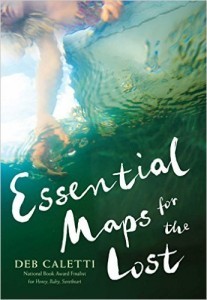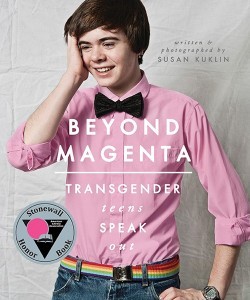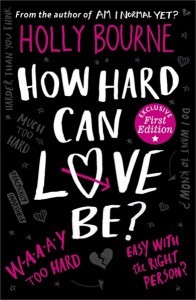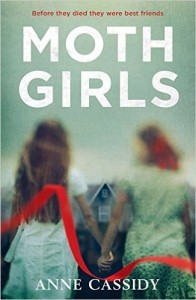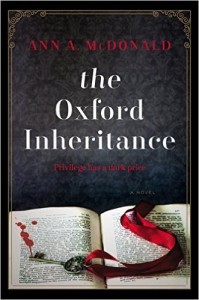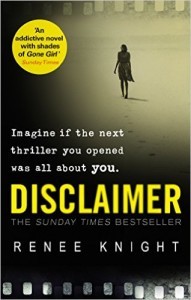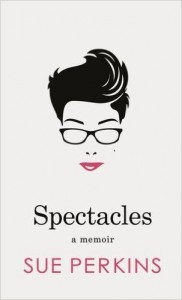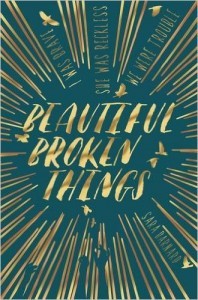Claire Hennessy's Blog, page 18
March 16, 2016
Book Review: Essential Maps For The Lost
“A husband might ditch the joint, but a daughter never can,” eighteen-year-old Mads reflects. Having graduated high school early, she’s now living with her aunt and uncle taking an intensive community college course so she can get her realtor’s licence, and join her mother’s practice. Never mind that it’s not what she wants – that her dream is to study English at university – this is the path that’s been set out for her. And she’s drowning in it.
This sophisticated YA novel by the prolific Seattle-based Deb Caletti, who’s produced a book a year for over a decade, is set near the water, and drowning both metaphorically and literally is at its heart. On a morning swim, Mads encounters a dead body and pulls it to shore, an experience that pushes her further into the depression that she’s struggling with. She becomes obsessed with the drowned woman, who threw herself off a nearby bridge, and goes to her old home – where she meets her nineteen-year-old son, Billy, for the first but not the last time.
Billy is a decent guy, but haunted by his mother’s death and the years of upset before that; now he lives with his unsympathetic grandmother and steals badly-treated dogs from their owners, then deposits them at the shelter he works with, claiming that they’re ‘lost’. Without hammering the point home, we can see that both he and Mads are lost in their own way, living in a world where terrible things happen and there are no easy answers. “A why without an answer,” Mads thinks, “is the worst kind of lost thing – a lost thing you never had to begin with.”
And then there are maps – the maps that can help lost travellers along the way. Billy’s mother’s favourite book was From The Mixed-Up Files of Mrs Basil E Frankweiler by E L Konigsburg, and he still carries around the map from within the novel – a floor plan of the Metropolitan Museum of Modern Art, where the two characters in the book run away to. Mixed-Up Files becomes a touchstone for Mads and Billy, and this novel – deviating from Caletti’s usual tendency to write in the first person – uses the same ‘God voice’ that Konigsburg adopts, allowing us to see two rounded, imperfect characters trying to figure out how to deal with the different kinds of grief that hit us in life – and how to handle the love that sometimes feels too scary or fragile to trust.
Caletti’s prose is fresh and quirky without ever getting irritating; optimistic without being saccharine. As in her other YA novels, the teenage protagonists being the central focus doesn’t mean that the others – the adults, the children, and the dogs – in their world aren’t carefully characterised as well. Fans of Gayle Forman’s I Was Here or Jennifer Niven’s All The Bright Places should pick this one up.
March 8, 2016
Book Review: Beyond Magenta
A 2015 Stonewall Honor Book, Beyond Magenta looks at six young people and their gender identity, encompassing individuals who identify as trans, intersex and non-binary. Author Susan Kuklin keeps her own comments to a minimum as she transcribes interviews with these people, interspersing the text with images; the afterword reveals that the interviewee had the chance to read through the material before publication to ensure it was an accurate depiction of their take on things.
I wanted to love this book, to connect with it, to be able to point to it when I’m teaching or working with young trans or genderfluid humans and say, hey, yeah, that book really got it. But I don’t think it does. In so many ways it feels dated already – it uses the term ‘transsexual’ much more than ‘transgender’, for example, and the idea of ‘cisgender’ never once makes an appearance. And as hypercritical as Goodreads reviews can be, I have to agree with those who’ve noted that the range covered here is very small – we’re looking at individuals within a big city (New York), mostly attending the one clinic. There is racial diversity even within this, but it doesn’t seem representative of trans teens overall – what about those, for example, who don’t have access to therapeutic and hormonal treatments?
And the book does itself no favours by having, in its first two sections, two people whose trans identity seems entirely predicated on outdated stereotypes. Jessy reports that, “Everything I’ve learned as a man comes from my father. Be strong. Don’t cry. Don’t whine.” Maleness is linked with doing sports and not being girly. It gets even worse with Christina, who talks about how she loves shopping and not sports, and recounts this conversation with her therapist:
“I don’t know. I just want to finish college and get a job and have a husband. I just want to be a housewife. I want to cook and I want to clean. I want to take care of the kids. I want to do all that.”
“You know what you sound like? You sound like a traditional woman.”
“What do you mean?”
“Everything that you’re saying is from a woman’s perspective. Staying home, cooking, taking care of kids. That’s what women do, traditionally. That’s what they were known to do.”
“Okay, then, I guess I’m a traditional woman.”
There are certainly points to be made about the extent to which trans individuals can feel under pressure to perform their gender roles in a very extreme, idealised way – to prove their femaleness with heightened femininity and to feel that wearing more gender-neutral attire might cause others to question their status as women. Or to prove their maleness with aggressiveness, although this seems to be less of an issue. But reducing gender identity to 1950s ideas of the perfect housewife is depressing.
Other accounts are more nuanced, explaining, “It was like I’m not born who I am, I have to transition to be who I am.” Cameron, preferring they/their pronouns, addresses the hormone question by saying, “I tried to help my parents understand how much more comfortable hormones will make me… I emphasized that hormones will help with all the awkward moments in public when people misgender me.” They also offer up astute comments on the way in which the gender binary doesn’t work for so many people, and how despite being read as masculine, they are not interested in adopting stereotypical behaviour. I also adored the final section, focusing on Luke’s experience with slam poetry – “There’s a lot you can say in poetry that you can’t say in conversation” – and theatre as means of self-discovery and self-expression. An entire book along these lines would have been welcome.
So, no, it’s not a book I’ll be recommending in its entirety to young people, or indeed to anyone. I wanted it to be. But even the resources feel out of date – the two (two!) fiction suggestions are Jeffrey Eugenides’s Middlesex and Julie Anne Peters’s Luna – and while we certainly need more books about the trans experience, particularly for young people, we also need better books than this.
March 1, 2016
Book Review: How Hard Can Love Be?
“Sometimes I think it would be so much easier if I wasn’t a feminist. I could just concentrate on looking pretty, and turn on the TV and not feel sick with rage that there’s hardly any female MPs on the news channel, and all the other women on TV don’t have any clothes on. I could pick a boyfriend who’s just such a macho douche, and think he’s the bee’s knees, and shower him with blowjobs and bake him cookies and think how lucky I am that he chose me. But it’s not the right thing to do!”
So rages Lottie, one of three members of the Spinster Club, on a transatlantic Skype chat with Amber, narrator of the second volume in Holly Bourne’s ‘Normal’ trilogy. Lottie will get her own story in the third volume, and we’ve already heard from Evie, whose struggles with boys and OCD formed the basis for Am I Normal Yet? But this is very much Amber’s story – Amber who is tall, redheaded and just a little bit scary. Amber who drinks maybe just a little too much despite – or sometimes to spite – her mother’s alcoholism, a situation leading to her parents’ divorce and her mother’s absence from her life for the past two years. Amber who just wants to spend the summer with her mum – even if that means putting up with her new partner, ‘Bumface Kevin’, and helping out at the camp he runs in the Californian mountains. Amber who just needs so many hugs and to be loved – because while she has two best friends that are like family, she can’t help feeling haunted by her mum’s abandoning of her.
While Holly Bourne has described this as lighter than Evie’s story, a summer camp romance published in time for Valentine’s Day, it hits just as hard and is just as funny. The balance between serious issues and comedy is often tricky for writers, but Bourne makes it seem effortless. Amber’s first love – with a former Prom King, at that! – is handled beautifully, with both characters coming off as real and authentic and flawed but also very much attracted to one another. And as with the first book, there are so many gorgeous small details that charmed me – the way Kyle is into musicals and concept albums because he likes music that tells a story, the references to Harry Potter and the outrage of removing Slytherin as a camp team name.
I’m completely smitten with this trilogy. How many YA novels feature characters discussing the work of Ariel Levy and applying it to their lives? (I can’t wait until we see Lottie – who is the most academically-minded of them all and has read every single key feminist text – tell her story.) Feminism in their world is real and immediate and important – it’s not a distant theoretical concept but something that shapes how they think about the world and how and why they strive to make it better. It’s also a thing that brings girls together rather than separates them – even though Amber can’t stand the overly-flirtatious girls at camp, there is still some empathy and an attempt to understand why people adopt certain behaviours. It’s something that strengthens the bond between the Spinster Club members – three smart, passionate girls who care deeply for one another and who can (and do) lust after boys without sacrificing their friendships. And who can have a laugh, too. If there is a teenage girl in your life who hasn’t encountered the wonder of Holly Bourne’s work, get these books into her hands now.
February 23, 2016
Book Review: Moth Girls
Five years ago, Mandy’s two best friends, Petra and Tina, disappeared. Two twelve-year-old girls drawn to a creepy old house like moths to a flame – it makes for a good story, and haunts the neighbourhood still. And Mandy, too – she’s seventeen but still in therapy, and still shaped by the experience. She’s attracted to the one boy who doesn’t know her as the girl who got away – the one who decided not to follow the others into the house and who kept a secret for five hours that could have meant the difference between life and death.
And now she’s convinced she’s just seen Petra again – but it’s not the first time she’s imagined this. It’s just someone who looks like her, Mandy tells herself. Until she gets the note. Until she discovers there’s more to that evening five years ago than even she knew.
This is a creepy, twisty tale about friendships between girls and the cruelty that can go along with it. Mandy was an outsider, trespassing on an existing friendship, and part of why it haunts her so much is that she’s never been able to move past those feelings of exclusion. And Petra has her own story to tell – about the dangers close to home and the things people will do to escape them. A sharp psychological thriller for teenagers from the prolific Anne Cassidy.
February 16, 2016
Book Review: The Oxford Inheritance
“This was an odd, timeless place, a city out of step with the rest of the world, where walking down an empty backstreet along the snaking line of an ancient college’s walls, Cassie could almost forget which century she was in – until a cluster of noisy undergrads spilled out of some back-alley pub, with their modern fashions and noisy buzz of cell phones breaking the spell.”
Oxford: renowned. Ancient. Privileged. When American transfer student Cassie Blackwell arrives, she’s in the perfect position to notice just how strange and formal a world it is. Like her fellow classmates, she’s there to learn – but she has something more on her mind than the syllabus. Her mother – beautiful, troubled, wild – was once a student here, something she never revealed to Cassie when she was alive, and now Cassie’s determined to find out what made her flee to the States, change her name, and adopt a nomadic lifestyle.
Through her roommate she becomes friends with some of the most privileged students on campus – the kind of elite that will rule the country and even the world one day. But there’s something sinister about them, even as she finds herself drawn into their web. This modern-day gothic novel is an addictive page-turner, with a subtle commentary on privilege and the British class system. Ann A McDonald (previously writing as Abby McDonald) draws on her own experience of Oxford to bring this secret-society thriller to life.
February 10, 2016
Dublin YA dates for the diary
Some YA dates for the diary!
Thursday February 11th (6pm): the fabulous Holly Bourne is coming to Eason’s O’Connell St for a Spinster Club night, celebrating the release of her second ‘Normal’ book, How Hard Can Love Be?
Thursday February 25th (6.30pm): the launch of Deirdre Sullivan’s new novel, Needlework, also in Eason’s – a book that will break your heart
Thursday March 10th (7pm): Dave Rudden’s The Knights of the Borrowed Dark is launching in Smock Alley, a gorgeous treat for Irish readers who can get their hands on this book before UK readers!
Saturday March 12th (5pm): as part of the Mountains to Sea Festival, there’ll be a panel discussion featuring Patrick Ness, Sarah Crossan, Louise O’Neill and Cecelia Ahern (whose debut YA is out next month)
February 4, 2016
Book Review: Disclaimer
A successful documentary maker who loves her husband and adores – though is often disappointed in – her son, Catherine’s been keeping a secret for twenty years. When a book turns up in her new home – a self-published title that she can’t remember buying – she realises that the main character is her, and that it’s the story of what happened all those years ago. But there’s an ending that never happened – Catherine’s seemingly-accidental death, pushed in front of a Tube train.
Or rather, it’s an ending that hasn’t happened yet. In alternating chapters, we learn about Stephen, a retired widower schoolteacher who has typed up his late wife’s novel and brought it into the world. He’s out to get Catherine, and punish her for what happened – or what he thinks happened – twenty years before.
This is a twisty read with a few swerves that you might guess, and others that will take you by surprise. I gobbled it up in one day, and while there were certain aspects of the ending that felt a bit too easy, there were other details that really pleased me. Fans of domestic suspense (Gillian Flynn, Paula Hawkins, Ruth Ware) will enjoy.
January 28, 2016
Book Review: Warped
Picard and Worf find themselves trapped in a cave. Data and Riker are stuck in a DIFFERENT cave. Troi and Wesley? Cave.
— TNG Season 8 (@TNG_S8) March 8, 2012
One of the more magical things on Twitter are parody accounts – wit and brilliance and mockery beautifully condensed into 140 characters. @manwhohasitall highlights the ridiculousness of advice given to women, offering advice on ‘me time’ and conquering ‘daddy guilt’ for busy working dads. @broodingYAhero is the hot, manly YA love interest you know you want, while @YourRTEGuide is a delightful take on Irish telly.
A few years ago I discovered one of my all-time favourites – @TNG_S8, bringing the world the plots of the ‘unaired eighth season’ of Star Trek: The Next Generation, with a perfect blend of fondness and snark:
Wesley's dino experiment mistakenly mixes with Riker's beard DNA, creating the sexy-but-dangerous Velociriker. Troi's mom tries to marry it.
— TNG Season 8 (@TNG_S8) April 30, 2012
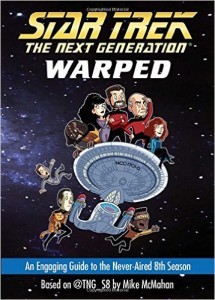
But now it turns out these episodes were, in fact, filmed, but never aired; it was “a season so un-airable that it would kill the show and allow everyone to finally get a full night’s sleep.” Assisted by quirky illustrations from Jason Ho, Mike McMahan delivers up full guides to these twenty-six episodes, with plots ranging from the deranged to the – well, even more deranged. Funny as the storylines are, my favourite sections are the ‘trivia’ and ‘mistakes and goofs’ notes that follow each description.
“When Data tours the Starfleet Academy campus, he remarks that the petunias are looking lovely. Viewers will have no problem seeing that the object being discussed is, in fact, a large rock with a sticky note on it. The note reads, ‘Darryl, please replace with SFX flowers in post.’”
It’s a funny, and incredibly silly treat for Next Gen fans – it provoked proper laughing-out-loud moments for me. As McMahan puts it, “It might not be the most important Trek book, but it’s definitely the one with the most Data and Geordi jokes.” Not to mention just the tiniest bit of shade thrown at other series in the franchise:
“The talking wooden dinosaur skeleton that Geordi befriends on Gift Shop Island was originally written to return with the away team as a potential new addition to the Enterprise crew, but budget limitations forced the writers to abandon the plan. They later brought the character back, with slight modifications, as Ensign Harry Kim in Star Trek: Voyager.”
January 21, 2016
Book review: Spectacles
Confession: I’ve never actually seen that show. You know the one I mean. With the baking. The cakes. That one. I know people have a lot of feelings about it, but I’d rather, well, eat food than watch it. Nevertheless, I do adore Sue Perkins – my heart skips around a bit when she turns up on one of the British panel shows to be funny and snarky and clever. Funny women aren’t exactly rare, despite what the media would have you believe, but you do notice them. You admire them. You do things like suggest questions such as “how are you so awesome?” when they are being interviewed for Diva magazine.
But I digress. Spectacles – as in glasses but also making a show of oneself – is a memoir which offers up humour, as you might expect, but also much poignancy. Yes, we hear about the mishaps in the school play, or about going to Edinburgh to perform a drastically under-rehearsed sketch show, but this is much more about growing up and the sad things that happen to us. When Perkins introduces us to her father, he is funny, absolutely:
“Dad: Ronnie Corbett’s children were at that school with you.
Me: Is that pertinent?
Dad: No, it’s name-dropping.”
But then she tells us about when he gets sick, about the hospital, and things get real:
“It was a men-only ward. Strong men. Fathers. They had been the axis on which their children plotted their burgeoning lives. And here they all were – brought down, levelled, lying there in hastily bought pyjamas and kept awake by each other’s coughs, moans and excretions. Welcome to the grim camaraderie of cancer.”
It’s pretty far removed from laugh-a-minute stuff, and there’s something sharp and painful in how she tackles our view of cancer and of being ‘a survivor’. It’s hard, she says.
“It returns you to your home a different person. It changes you, changes your world view. Sometimes it changes you for the better – you’re more resolved to squeeze the juice out of your remaining years. That at least is the trope we most often see in books and films. But sometimes it returns you scooped out and hollow – resentful that you’ve worked yourself to the bone for nearly fifty years and that what was supposed to be the glorious era of retirement has been scarred by disease and incapacitation.”
It’s not just what her father’s going through. It’s everything, it’s life: when her comedy partner Mel gives birth to her first child, Perkins reflects: “… that night was perhaps the first time I had to contend with the painful reality of being a grown-up – that messy, unarticulated feelings stay with you for ever without finding resolution.” There is a letter to her dead dog, which brings a tear even to the eye of this firmly cat-person reader. She describes what it’s like to discover she’s infertile, the result of a benign brain tumour. It’s all beautifully conversational but also sadder than you might think from the light-hearted cover. That being said, it’s by no means a misery-fest – how can it be when we hear that her term for repeatedly coming out to her dementia-suffering grandmother is “GROUNDHOG GAY”? Or that, when on the dangerous roads of Alaska, she has an epiphany:
“It’s amazing what you learn about yourself when you come face to face with death. What I learned is that when I confront my own mortality I like to do it in the voice of Fenella Fielding.”
Oh, Sue Perkins. How are you so awesome?
January 14, 2016
Book review: Beautiful Broken Things
There are not nearly enough YA novels about the passionate intense friendships that characterise so many teenagers’ lives, where it’s not just the people you’re kissing but the people you sneak around with, or share secrets with, or fight with, who occupy your thoughts and feelings. Sara Barnard’s debut novel is about female friendships in all their intensity – from the hero-worship and resentment of a new girl arriving into the mix, to the exhilaration of having a friend who makes you brave and inspires you to have the kind of adventures and significant life experiences you’ve always wanted.
Caddy is sixteen, and a nice girl – a quiet, uneventful sort who goes to a private school and excels academically but isn’t as much of an overachiever as she’s expected to be, in that environment. She dreams of having things happen to her, of losing her virginity and falling in love, of being the sort of interesting person that her best friend Rosie is. Caddy knows that bereavement and mental illness don’t make your life more worthwhile, but yet she’s fascinated by trauma in a way she can’t quite articulate – and perhaps a little guilty and jealous at the same time for not having anything of the sort in her own life.
Rosie’s new friend Suzanne is at first a source of worry for Caddy. Suzanne is beautiful and sarcastic and fun – infinitely more fun than Caddy. Suzanne attends the same (normal, non-overachieving) school as Rosie. Suzanne is a threat. But after a little online stalking, Caddy discovers that there’s something troubling in Suzanne’s background, and manoeuvres a group conversation to prompt Suzanne to get upset, and then reveal, the abuse she suffered within her family and explain why she’s now living with an aunt.
Caddy doesn’t quite want to ‘save’ Suzanne, but there’s also another part of her that feels privileged to be chosen as her friend, to be the one trusted enough to hear some of the secrets and join her on midnight wanderings. The friendship that develops is as intense as any crush and just as potentially heartbreaking; after a fight where Caddy realises she hasn’t been included in all of the secrets, and Suzanne lashes out at her, she reflects:
“There’s something deeply upsetting about having your deepest insecurities not just laid bare by a friend but thrown in your face. I knew I was not in any way exciting, that there was nothing going on in my life that could be remotely confused with interesting. I’d always worried that this made me boring and that that was what people thought of me: Caddy Oliver – nice, but dull. And now, clearly, that was true.”
Being Suzanne’s closest friend is hard work. Caddy understands that her life is difficult – but she’s also not privy, until much later, to some of the more upsetting and dangerous elements of Suzanne’s behaviour. And she wants to support her friend without letting her get away with murder: after an apology from Suzanne, Caddy thinks, “I didn’t say anything, torn between reassuring her that I wasn’t about to desert her and pointing out that she’d acted like a bitch.” The fact that her parents disapprove of the friendship doesn’t help – Caddy finds it hypocritical that her mother, who works with the Samaritans, isn’t interested in helping someone in real life; her father, a doctor, is equally more concerned with saving people at work than in seeing what’s going on at home. What’s wrong with being a good friend to someone who clearly needs one?
This is in some ways Jacqueline Wilson’s Bad Girls for an older audience, and in other ways like stepping back into your teenage brain. The authenticity of the girls’ exchanges – the in-jokes, the intense appreciation for one another, the bitchiness – is incredible. Beautiful Broken Things is already one of my favourite YA books of 2016.

